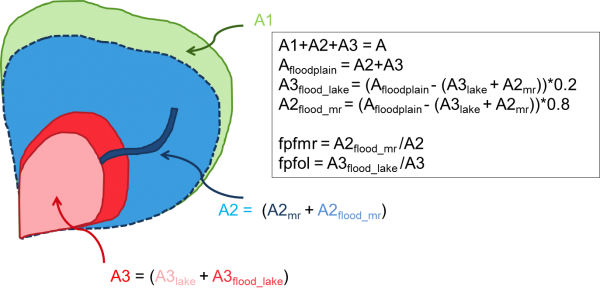Navigation
HYPE Documentation
Quick links to often-used pages:
HYPE links
HYPE OSC (model code)
HYPE Open data access
SMHI Hydrology Research Dep., main developer and maintainer of the HYPE model
Quick links to often-used pages:
HYPE OSC (model code)
HYPE Open data access
SMHI Hydrology Research Dep., main developer and maintainer of the HYPE model
This is an old revision of the document!
A river or lake that flood over its borders and cause a large area of standing water may be simulated with the HYPE floodplain functionality. Read more about how the floodplains work in the model description section Floodplains.
A HYPE floodplain can only be formed from water that flows from a main river or an outlet lake; local streams and internal lakes cannot have an associated floodplain area. The floodplain and its water body are considered as one unique slc-class, and this class' area is the maximum extent of the floodplain. This means that floodplains do not constitute a new slc class and therefore the (previous) class area, that is the water body area (of main river or outlet lake), becomes larger to include the possibility to be flooded.
The modelled floodplains are described mainly by information given in the FloodData.txt file and by some parameters in the par.txt file. The information in FloodData.txt can be grouped in three categories:
fpfol, fpfmr)floll, flolp, flmmr, flmrp, fymol, fymmr)rclfp, rclpl, rclfp, rclpr).These input data can be estimated in different ways. The suggestion here is to define those that can be observed/derived relatively easy from data (area and elevation threshold) and manually calibrate the others (recession coefficients). A method to do that is described below:
Area related data
fpfmr and fpfol are defined this way.  |
Figure 1: Example of determining fraction of floodplain area (fpfmr and fpfol). A represents the whole subbasin area, the subscripts lake and mr, outlet lake and main river, respectively. |
The input data values needed can be estimated in different ways and also be calibrated in HYPE. Here we describe one method to determine input data. For each subbasin that have a floodplain repeat these steps:
fpfmr and fpfol. The rest of the classes' area is river or lake surface area.fymmr and fymol.flmrr and floll.flmrp and flolp.rcrfp, rcfpr, rclfp, rcfpl). The recession coefficients must be between zero and one. A recession coefficient of one gives a fast response.